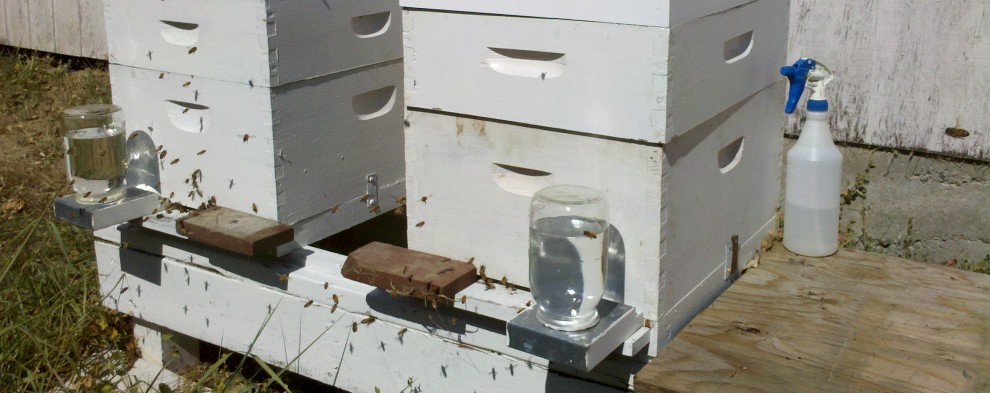Q-Tried to do this survey online and failed. Section4: the format did not allow to enter the necessary information and, short of making numbers up, the survey doesn’t let you continue to the next page. Very frustrating.
Section 3b: These numbers are a guess and can be misleading. All we know is that after combining, requeening with nucs, and equalizing colonies in Jan 2015 from what had been 64 overwintered “units”, we ended up with 55 queenright colonies (pollinating units for CA almonds).
Section 4 Origination: Because we sold the majority of our 2013 overwintered and 2014 split hives, these numbers are a guess (the rations not the total). It’s too time intensive to figure out form the records which of the surviving colonies originated in 2013 or as in 2014 as a split.
Section 7.1 Sorry but for me this survey looses in credibility when it uses “minimal hive inspection”, “Apiary colony configuration” and “Apiary site selection” are listed as options for mite control practices. If some people feel that way, why not let them write it in under “other”?
—
A-Response to Semi-Commercial Beekeeper
I appreciate your attempting to do an electronic survey on 2014-2015 bee losses. I am sorry you had such difficulties with the electronic site and had to send a paper copy. Your effort was commendable.
The survey is meant for backyarders – those with one to a couple of apiary sites – so it is not easy for operations such as —— to fit answers into the offerings (either of the electronic or paper versions).
You indicted on Section 2 – the section used to compute losses – that this was a difficult question to answer – but what you sent is exactly what we were looking for. You indicated of 64 fall colonies 55 were counted in the spring after all the management. Those with 1000’s of colonies have the same issue and round numbers to send back a survey – I realize they are only “estimating” overwintering losses – and likewise their numbers of summer losses. Our national BIP survey and this one Ramesh and I are doing for PNW is, in reality, a “snapshot” – we recognize and understand that it is not always possible to provide “real” numbers. This data is still very useful…..right now it is the “best” we can hope for with a survey instrument – we are also doing counting and surveying with “real” numbers – for example what Dan & Ellen are doing with the Tech Transfer sampling + our Tier 4 numbers (People need to pay for this survey assistance). Ramesh and students have other studies, some in conjunction with cooperators and others using OSU colonies, that are “real” numbers.
Under comment section you said the questions should be rephrased so it might be” easier/possible” to respond. In particular, you commented that survey “loses credibility when items like minimal hive inspections, apiary colony configuration and apiary site selection are listed as options for mite control practices“and you suggested that persons who feel that way should write have to include them under “other” In fact, that is the option for the paper survey sent to commercial and semi-commercial (your colony numbers would have us classify you as semi-commercial). As indicated, the electronic survey (and the paper copy you submitted) was never intended for commercial or semi-commercial beekeepers.
As for our checklist of items under sanitation – it makes sense to collect data to show what Oregon/Washington backyarders are NOT doing for proper sanitation or what COULD be done and then we see if it will make a difference – they do apparently make a difference for smaller colony numbers and may especially be effective under light mite population pressure (depending upon what we term “effective” or “success”. If basic sanitation means 10% fewer losses (about the same as some studies have shown for use of a screen bottom board for example) that could Be EFFECTVE or SUCCESSFUL by someone’s standards. Science does show that colonies in the sun (apiary site selection) have “reduced mite populations” and there is some evidence that if efforts are made to reduce drifting from one colony to the next, the mite populations of some colonies are within limits that suggest the colonies are holding their own when mite population pressures are lower – so is that “effective” or Success”?
The “kicker” is that viruses change the whole situation since it is mites + viruses that kill colonies so quickly. Also one colony generating mites in an apiary (I label them “mite bombs” in my talks) do share their mites with others in same apiary as they get weaker and under more stress. So does good sanitation make any sense? Well I don’t know – but I thought the survey could help provide some real answers – sorry you feel that by including such survey questions that the entire survey losses credibility.
Our survey – is designed to get some basic information. I am able (with 250 backyard respondents this spring) to run correlations between loss and these various options. If apiary site selection is ineffective the data should help to define this (correlation is not causation). I do appreciate your effort to be included.
